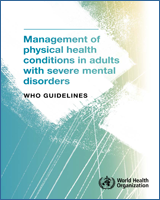The recommendations in these guidelines must be implemented using a person-centred and integrated approach to address factors associated with excess mortality in persons with SMD. This integration is needed at four levels – screening and early detection of physical health conditions, counselling for behavioural risk factors, assessment and management of cardiovascular disease risk and management of established physical and mental health conditions.
We propose a multilevel intervention framework that will be useful for designing, implementing and evaluating interventions and programmes to reduce excess mortality in persons with SMD (Liu et al., 2017). The first level is individual-focused interventions. The second and third levels of the framework consist of strategies focussed on the health systems and socio-environmental context, respectively, which provide the enabling environment for implementation of the recommendations.
The individual-focused interventions i.e. strategies delivered to individuals with SMD to target their mental health condition, physical health and lifestyle behaviours should be guided by the recommendations proposed in these guidelines.
Health screening facilitates early detection and treatment for many of these conditions, though rates of screening in people with SMD appear to be reduced compared with the general population. A UK survey (Patel et al., 2014) found that only 33% of people with schizophrenia had received adequate cardiovascular disease screening in the previous 12 months. Effective interventions for increasing access to, or uptake of, screening for a range of conditions in the general population (Camilloni et al., 2013) exist. A recent review identified interventions to increase both access to and uptake of physical health screening in people with SMD amongst which are staff and stakeholder involvement in screening, staff flexibility when taking physical measurements (e.g. using adapted equipment) and strong links with primary care (Lamontagne-Godwin et al., 2018).
Psychosocial interventions that promote adherence in people with SMD are particularly important when addressing physical health conditions. This can also take the form of generic advice and psychoeducation at the time of diagnosis of the SMD.
Adherence to medication guidelines − such as the American Schizophrenia Patient Outcomes Research Team (PORT) Treatment Recommendations (Kreyenbuhl et al., 2010) − appear to have an effect on reducing mortality in schizophrenia. These, along with other specific recommendations for psychosocial treatments as described in these guidelines, are important considerations when developing intervention plans for people with SMD. The full participation of persons with SMD in their treatment and recovery plans is a very important factor in improving health outcomes (Vahdat et al., 2014).
The next level in the framework encompasses strategies within health systems targeting health care providers and service delivery components. These will vary across different settings depending upon many parameters, such as the number of specialists versus primary care providers, the different distribution of health risk factors, the presence or absence of universal health care, and the availability of health technologies and medications. Strengthening of the six building blocks of the health systems – service delivery; health workforce; information; medical products, vaccines and technologies; financing; and leadership and governance (stewardship) – would improve outcomes for persons with SMD.
Care coordination, collaborative care or integrated care programmes that include support to better equip health systems, usually through the provision of additional supportive members who can serve as a liaison between mental health and physical health care systems or through linking of delivery of physical and mental health services are particularly important. Mental health practitioners need to be better at physical health skills, as well as physical health clinicians/systems being better at addressing needs of people with SMD.
In countries with limited resources, evidence suggests that mental health care can be delivered effectively in primary health-care settings, through community-based programmes and task-shifting approaches. Non-specialist health professionals, lay workers, affected individuals, and caregivers with brief training and appropriate supervision by mental health specialists are able to detect, diagnose, treat, and monitor individuals with mental disorders and reduce caregiver burden. Physical health in people with SMD should also be considered in community-based programmes and task-shifting approaches (Kakuma et al., 2011).
The broadest level of the framework incorporates socio-environmental factors and the social determinants of health. This part of the model acknowledges the range of potential strategies originating from the community to address contributors to premature mortality such as peer and family support programmes and stigma reduction programmes. At a wider level, public health policies providing mental health parity are essential to improve lives of those with SMD. A twin-track approach is likely to work best with improved public health for all, recognising that the broader social determinants like poverty affect certain groups more, and, targeted interventions for at-risk groups. Strategies at the policy level that affect screening or management of HIV, TB or tobacco consumption are especially relevant to those with SMD and may have even greater effects on the health and well-being of this high-risk population.
The recommendations contained in these guidelines should be adapted into a locally appropriate document that can meet the needs of each country and its health services. WHO headquarters will work closely with the regional and country offices, as well as implementing partners, to ensure communication and country-specific adaptations of the guidelines, through regional and national meetings.
As countries consider how to implement these guidelines, the budgetary and human resource requirements, and other health systems implications should be analysed to identify which inputs and systems are currently available, and which areas require additional investment, including training of health workers; supply of medicines; and adaptations of health information systems to collect data on service utilization.
To support country implementation, WHO will produce a series of subsidiary tools that will address clinical and service delivery aspects of the implementation of the recommendations included in these guidelines.

